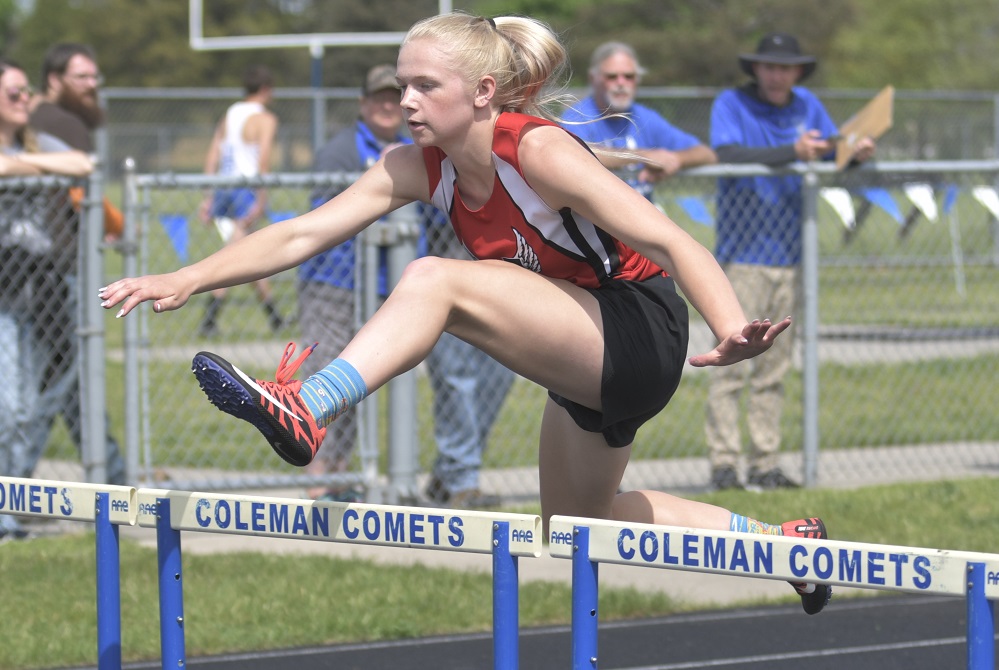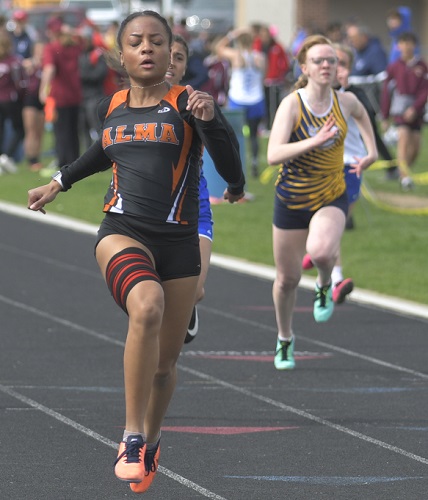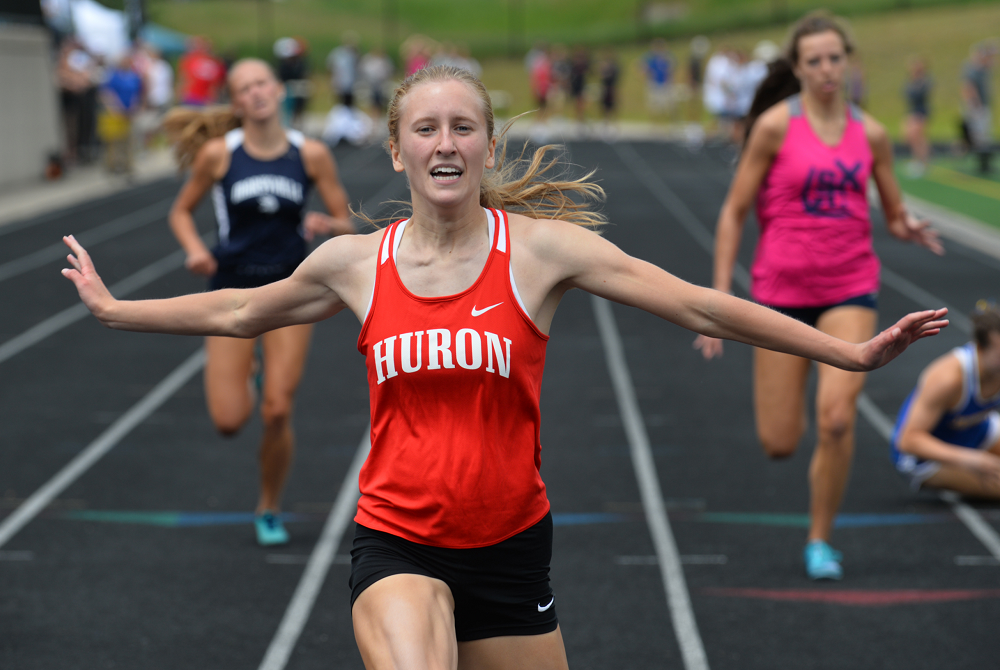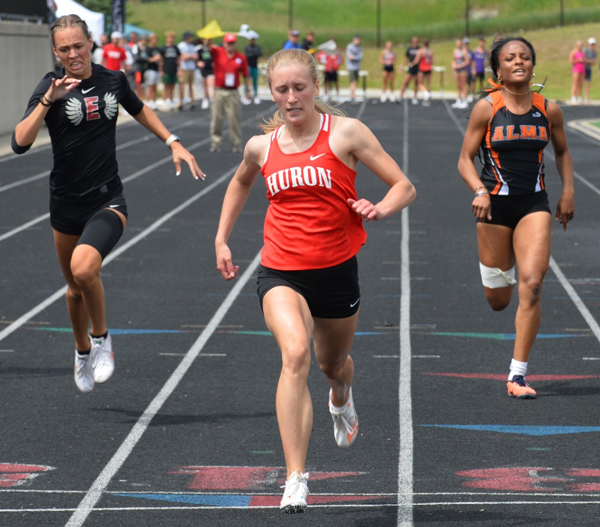
Preview: Opportunities Await for Standouts to Join All-Time Greats
By
Geoff Kimmerly
MHSAA.com senior editor
June 2, 2022
Winners of 26 individual titles from the 2021 Girls Track & Field Finals will be back at Saturday’s Lower Peninsula championship meets hosted by Rockford, Ada Forest Hills Eastern, Kent City and Hudsonville Baldwin Middle School.
Events begin at 10 a.m. (EDT) and tickets to attend can be purchased online only at GoFan. The meets also will be broadcast on MHSAA.tv and viewable with subscription.
Below is a glance at team contenders and individuals to watch in all four divisions.
Division 1 at Rockford
Team forecast: Oak Park has been the standard most of the last decade, last season winning its third-straight Division 1 championship and sixth in seven seasons (not counting the COVID-canceled 2020 season). Detroit Renaissance finished runner-up for the second straight Finals, but has the star power and depth to make a run at its first championship since finishing a run of 10 titles in 11 years in 2007. Rockford, Ann Arbor Huron and Ann Arbor Pioneer are others with an intriguing mix of possible event champions and qualifiers in numerous events.
Julia Flynn, Traverse City Central senior: Flynn has been among the state’s elite distance runners every fall and spring since the start of her high school career, and she enters her final race day for Central pursuing a first championship as the top seed in the 1,600 (4:53.88), second seed in the 800 (2:13.51) and fourth seed in the 3,200 (10:55.36).
Kaila Jackson, Detroit Renaissance senior: The three-time Finals sprint champion could make a run at the all-Finals records in the 100 and 200 as she enters her last championship meet seeded first in the 100 (11.52) and 200 (24.17) and likely to run on the top-seeded 400 and third-seeded 800 relays. That 100 qualifying time would break the all-Finals record of 11.54 run by Mumford’s Shayla Mahan in 2006.
Sophia Mettes, Dexter senior: Last season’s pole vault champion is the second seed with her Regional vault of 12-3. But she has the highest vault in Michigan this season by six inches at 13-6 from her league meet three weeks ago.
Arianne Olson, Holland West Ottawa junior: She finished only four seconds off the lead as the runner-up in last year’s 3,200, and she’s seeded first in that race (10:18.57) by 24 seconds. She’s also seeded second in the 1,600 (4:55.85) and could run on multiple relays.
Mackenzie Robinson, Ann Arbor Huron junior: She seeded right after Jackson in both the 100 (11.66) and 200 (24.36) and is likely to run on the second-seeded 400 relay and third-seeded 1,600 relay as well. She was sixth in the 200 and seventh in the 100 last season.
Abigail Russell, Allen Park sophomore: She also could take a major step this weekend after finishing 15th in shot put last season. This time she’s seeded first both in shot put (43-0) and discus (131-5), and both by impressive margins.
Nonah Waldron, Oak Park junior: She won both the 100 hurdles and 300 hurdles at her Finals debut last season, and she’s seeded first in the 100 hurdles this time (13.88) by half a second, and seeded second in the 300 (42.66) only to sophomore teammate Morgan Roundtree. Waldron also will run on the top-seeded 1,600 and second-seeded 800 relays. She and Roundtree (42.42) should make a run at the all-Finals 300 record of 42.23 seconds.
Division 2 at Ada Forest Hills Eastern
Team forecast: Petoskey last season became the seventh team over the last eight LPD2 Finals to win the team championship. This season’s race is difficult to forecast. East Grand Rapids and Grand Rapids Christian both could score major points in distance competition, with the Eagles showing potential in field events as well. Madison Heights Lamphere, New Boston Huron, Allendale, Bridgeport, Petoskey for a repeat – in a low-scoring meet, all could have a chance, especially considering Petoskey was the only team to score more than 29 points last season.
 Elizabeth Anderson, New Boston Huron junior: After finishing third in the 100 and 400 and fourth in the 200 last season, Anderson could climb the podium multiple times. She’s seeded first in the 200 (25.48) and 400 (56.90) and fifth in the 100 (12.45).
Elizabeth Anderson, New Boston Huron junior: After finishing third in the 100 and 400 and fourth in the 200 last season, Anderson could climb the podium multiple times. She’s seeded first in the 200 (25.48) and 400 (56.90) and fifth in the 100 (12.45).
Madelyn Frens, Grand Rapids Christian senior: The LPD2 cross country champion in the fall also is back after winning the 3,200 a year ago. She’s seeded first in the 3,200 (10:58.33) by nearly 12 seconds and fourth in the 1,600 (5:04.61), and she’ll also possibly run on the second-seeded 3,200 relay.
Ella Jenkins, Warren Regina junior: A qualifier in the 100 hurdles last season who finished 11th in the preliminary, she’s improved literally with leaps and bounds. Jenkins is seeded first in both the 100 hurdles (14.95) and 300 hurdles (45.20) and could also run on the 1,600 relay.
Chaniya Madison, Bridgeport senior: The reigning champion in the 100 and 200 also won the 100 as a freshman. She’s seeded third in that race (12.36) for Saturday, her time only a tenth of a second from topping the list, and she’ll also likely run on the 400 relay and top-seeded 800 relay.
Reese Powers, Marysville senior: The reigning 400 champion is seeded second to Anderson in that race (58.77) and second in the 800 as well (2:19.58) after finishing 10th in that race last season. She also will run on the 1,600 relay.
Ryann Rohrer, Ludington senior: Her third place in shot put last season was only 3½ feet off the lead, and she returns as the top seed in that event (44-6) by 3 feet, 7 inches. She’s also the fourth seed in the discus (122-6).
Division 3 at Kent City
Team forecast: Pewamo-Westphalia has been the standard for most of the last decade with four championships over the last eight seasons (not counting canceled 2020), and the Pirates and Grass Lake tied for the title a year ago. Qualifiers throughout the meet should have P-W contending again – but Hart’s distance and relay talent might make it the favorite. Onsted also has high-scoring potential with two top-seeded relays and two of the top three seeds in the 400.
Lexus Bargesser, Grass Lake senior: The future Indiana basketball player missed her entire senior hoops season because of a knee injury but will be back this weekend as a five-time individual champion after winning the 100, 200 and 400 last season. She’ll run just the 400 this time, seeded seventh (1:00.36).
Lani Bloom, Ithaca senior: She’s looking to add to her 800 and 1,600 championships won last season and LPD3 cross country championship won in the fall. She’s seeded second in the 800 (2:18.22), fourth in the 1,600 (5:04.77), fifth in the 3,200 (11:18.28) and will run on the top-seeded 3,200 relay.
Allison Chmielewski, Roscommon senior: Last season’s runner-up in the 800 and 1,600 has been one of the state’s top distance runners throughout her career and will finish with a chance to be multi-event champion. She’s seeded first in the 1,600 (5:01.94), third in the 3,200 (11:12.25) and fourth in the 800 (2:21.66).
Mickenzie Brancheau, Kent City senior: The reigning high jump champ is among 10 who qualified with a Regional jump of 5-0 to 5-4.
Audrianna Enns, Hart senior: She has a chance to be high points scorer as Hart goes for the team title, seeded first in the 800 (2:16.25), sixth in the 1,600 (5:07.55) and running on two top-four seeded relays.
Kylee Poulton, Holland Black River senior: She could finish her high school career with one of Saturday’s biggest performances in any division, entering as the top seed in the 100 (12.23), 200 (25.39) and 400 (57.24) and running on the 1,600 relay. She finished second in the 100, third in the 200 and fourth in the 400 last season.
Annabelle Smith, Blissfield senior: The reigning long jump champion is seeded sixth (16-5½) in that event and also fourth in the 100 (12.65). She’ll also run the 200.
Division 4 at Hudsonville Baldwin Middle School
Team forecast: Fowler has won five of the last 10 championships including most recently in 2018 and 2019, and the Eagles are strong in relays with scoring possibilities all over this meet. Reigning champion Mount Pleasant Sacred Heart has three top seeds and relay strength as well, and Hillsdale Academy has two top-seeded relays and a third top seed in long jump that could put it in contention. Muskegon Western Michigan Christian, moving over after running in Division 3 last spring, also has a strong opportunity with distance and relay power.
Nicole Olivieri, Mount Pleasant Sacred Heart senior: Last season’s 400 champion is seeded first in that race (58.11) and the 200 (26.57) and will run on two top-four relays as well.
Aiden Harrand, Buckley sophomore: She won the 1,600 and was second in the 800 in 2021, and enters this weekend seeded first in the 800 (2:20.66), second in the 1,600 (5:05.54) and fourth in the 3,200 (11:49.22).
Makenna Scott, Maple City Glen Lake senior: Last season’s 3,200 champ and 1,600 runner-up is seeded first in the 3,200 (11:03.29) and third in the 800 (2:22.80) and 1,600 (5:09.92).
Jocelyn Hall, Athens junior: The reigning 100 hurdles champion is seeded third in that race (16.75) and will run on the sixth-seeded 400 relay.
Tara Townsend, Frankfort senior: She’s seeking to finish with her third pole vault championship in three tries (with 2020 canceled). She’s seeded second at 8-9 but has the sixth-best vault (tied) in the state this spring at 11-6. She’s also seeded fifth in the 100 (13.19), fourth in the 200 (26.96) and will run on the fourth-seeded 400 relay.
Emma Valentine, Morrice senior: The reigning high jump champ has tied for the sixth-best in the state this spring (5-6) and enters as the top seed with a 5-4 Regional jump.
Abigail VanderKooi, Muskegon Western Michigan Christian senior: She won the 3,200 in Division 3 as a freshman and junior and in the fall became the eighth runner in MHSAA history to win four cross country titles. She’s seeded first in the 1,600 (5:05.40), second in the 3,200 (11:13.12) and fourth in the 800 (2:24.87) and will run on the top-seeded 3,200 relay.
Tess VanDyk, Kalamazoo Hackett Catholic Prep senior: She swept the throws at last year’s Final and is seeded first in both with a toss of 40-0 in shot put and 125-5 in discus.
Allison Wichert, Vestaburg senior: She seeded third in the 300 hurdles (48.75) and seventh in the 100 hurdles after winning the 300 championship last season.
PHOTOS (Top) Vestaburg's Allison Wichert leaps a hurdle during her Lower Peninsula Division 4 Regional on May 21 at Coleman. (Middle) Alma's Trinity Greer, left, pulls away in the 100 during the Shepherd Invitational on May 6. She'll run the 100, 200 and on the 400 relay at the LP Division 2 Finals. (Click for more from High School Sports Scene.)

Multi-Sprint Champ Racing to Finish Huron Career Ahead of the Rest Again
By
Keith Dunlap
Special for MHSAA.com
May 25, 2023
NEW BOSTON – If there was one thing Elizabeth Anderson took pride in elementary school, it was simply showing that she could outrun everyone in sight.
 In fact, Anderson has an explanation for all the success she had in those playground races.
In fact, Anderson has an explanation for all the success she had in those playground races.
“Dominance when you are in elementary school,” Anderson quipped. “I don’t think I ever had a nickname. I just think everyone knew I was fast.”
Years later, pretty much everyone who follows track & field in the state of Michigan can attest to that.
A senior for New Boston Huron, Anderson has been faster than most other competitors in the state during her three-year high school career (with her freshman season in 2020 canceled due to COVID-19).
Last year, Anderson won titles at the Lower Peninsula Division 2 Finals in the 200-meter (25.07) and 400-meter (56.28) dashes, and was runner-up in the 100-meter dash (12.23).
Often, top sprinters focus on one or two of those three races. But Anderson is certainly a different breed of sprinter because she does all three.
In fact, she holds school records in all three of those events, and if all that weren’t enough, Anderson is a part of all three sprint relay teams.
“It is hard to give her events off,” said New Boston Huron head girls track coach Danielle Lobato.
Despite the different styles the 100, 200 and 400-meter dashes present, Anderson said there usually isn’t much adjusting when she goes from one of those races to another.
 The strategy is simply, “Let’s beat the other girls to the finish line.”
The strategy is simply, “Let’s beat the other girls to the finish line.”
“I don’t really go into each race changing up how I would run,” she said.
While enjoying and succeeding in all three races, Anderson said she actually does have a favorite among them.
“I would say the 400 is probably my favorite,” she said. “Even though it hurts, it’s satisfying to see how much you can get your time down in the 400 compared to any other race.”
Anderson said she started running track in sixth grade, but really got serious about it during the summer after her sophomore season, when she was invited to run for a local club.
Eventually, that led to her competing over the winter in indoor events.
She lived and breathed track so much that last fall, she decided to not run cross country so she could focus on a weightlifting regimen aimed at developing more leg strength.
“Once I started doing summer track, I realized I wanted to be doing this all the time,” she said.
Lobato said oftentimes in practice, Anderson is a de facto coach, given there is no better person she can think of for the younger runners on the team to learn from.
“I can’t always demonstrate these things I’m trying to teach,” she said. “You get to see it in real life (from Anderson), not in a YouTube video.”
After winning the 100, 200 and 400-meter dashes at her Regional meet last week, Anderson has her sights set on achieving the same trifecta of titles at next Saturday’s Finals in Grand Rapids.
Anderson has signed to run track at Michigan State, but has been plenty motivated to keep producing this spring in her final high school season.
“I’m really looking to defend my titles,” she said. “That is what is really motivating me to keep going. I want to keep in shape for the college season. I don’t want to lose any of the progress I have made. Ultimately, I just love running track.”
And since elementary school, Anderson has loved — and succeeded in — outrunning everyone else to the finish line.
“We knew we were getting something special,” Lobato said of when Anderson arrived in high school. “But you never expect this. All that she has accomplished is amazing.”
 Keith Dunlap has served in Detroit-area sports media for more than two decades, including as a sportswriter at the Oakland Press from 2001-16 primarily covering high school sports but also college and professional teams. His bylines also have appeared in USA Today, the Washington Post, the Detroit Free Press, the Houston Chronicle and the Boston Globe. He served as the administrator for the Oakland Activities Association’s website from 2017-2020. Contact him at [email protected] with story ideas for Oakland, Macomb and Wayne counties
Keith Dunlap has served in Detroit-area sports media for more than two decades, including as a sportswriter at the Oakland Press from 2001-16 primarily covering high school sports but also college and professional teams. His bylines also have appeared in USA Today, the Washington Post, the Detroit Free Press, the Houston Chronicle and the Boston Globe. He served as the administrator for the Oakland Activities Association’s website from 2017-2020. Contact him at [email protected] with story ideas for Oakland, Macomb and Wayne counties
PHOTOS (Top) New Boston Huron's Elizabeth Anderson clears the finish line during last season's LPD2 400 race. (Middle) Anderson, middle, outpaces the field to also win the 200. (Click for more from RunMichigan.com.)

